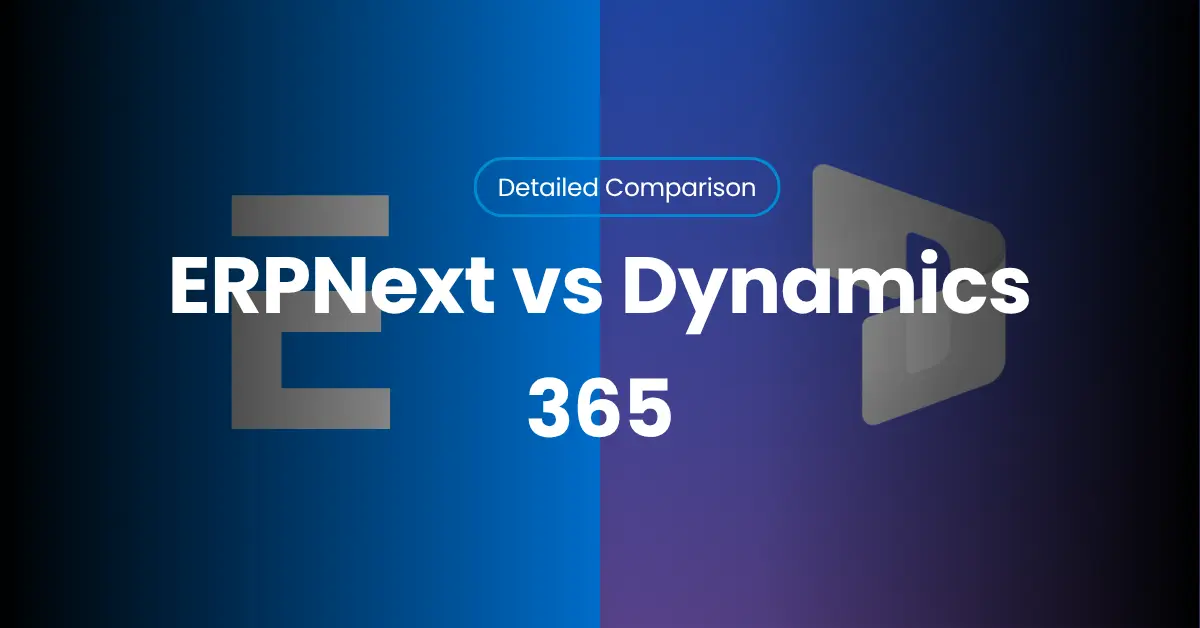For most manufacturers, only to stay competitive isn't the only option for production speed — it’s about visibility, accuracy, and control. When an organization utilizes more than one disconnected system, the chances of inefficiencies and errors also increase in sales, inventory, and production records. That’s where an ERP (Enterprise Resource Planning) system becomes necessary — it merges your manufacturing, finance, and supply chain operations, even every department under one digital roof.
Today, two names come up in our daily ERP discussions: one is ERPNext and the other is Microsoft Dynamics 365 (D365). Both are the best platforms according to requirements, but they differ mostly in design and pricing structure. ERPNext is an open-source ERP platform built for those organizations that want cost-effectiveness and self-management solutions. On the other hand, Dynamics 365, part of the Microsoft ecosystem, provides an enterprise-grade, subscription-based ERP suite with its advanced integration and automation.
Understanding ERP’s Role in Modern Manufacturing
A well-implemented ERP can change how manufacturers plan, produce, and deliver goods. Instead of transferring your data across spreadsheets and email updates, teams gain real-time access to data across every sector — from raw material purchasing to finished goods shipping. The result is fewer surprises, faster decisions, and higher profitability.
Without ERP, manufacturers usually face a familiar set of pain points:
- Manual reporting that delays production and decision-making
- Duplicate data entry across systems, like inventory and accounting
- Limited visibility into production bottlenecks or material shortages
- Inefficient scheduling, leading to excess labor or missed delivery dates
An ERP system eliminates these roadblocks by automating workflows, synchronizing information, and improving collaboration between shop-floor teams and management.
Meet the Contenders: ERPNext and Microsoft Dynamics 365
Both ERPNext and Microsoft Dynamics 365 are capable manufacturing ERP solutions, but they take very different routes to get there. Understanding their origins and design intent helps clarify which fits your business better.
ERPNext at a Glance
ERPNext is developed by Frappe Technologies. It's an open-source ERP platform and is best for small to mid-sized manufacturers(SMBs). Also, it's modular, cloud, and totally customizable — from production planning to accounting and HRMS. Because it’s open-source, businesses own their data and can tailor workflows without restrictive licensing fees.
For example, a metal-parts manufacturer using ERPNext can quickly adjust its Bill of Materials (BOM) or automate Work Order creation as product variations change — no vendor approval needed.
Microsoft Dynamics 365 in a Nutshell
Microsoft Dynamics 365 (D365) sits at the opposite end of the ERP list. It’s a cloud-based, enterprise-level ERP and CRM suite offering advanced analytics, AI-driven insights, and seamless integration with Power BI, Azure, and Office 365. Dynamics 365 Business Central and Finance & Operations are common modules used in manufacturing settings.
Large or multi-plant operations often choose Dynamics 365 for its scalability and robust governance. Its structured customization through certified partners ensures consistency — though that rigor can also extend implementation timelines.
That said, both systems share a common goal: helping manufacturers streamline operations, reduce waste, and improve planning accuracy.
ERPNext vs Microsoft Dynamics 365: Core Manufacturing Features Compared
Choosing the best ERP means evaluating how each platform supports the daily realities of production — from Material Requirements Planning (MRP) to Quality Management and Shop Floor Control.
| Feature | ERPNext | Microsoft Dynamics 365 |
| Bill of Materials (BOM) | Flexible, multi-level BOMs with real-time costing | Advanced BOM versioning with engineering change control |
| Work Orders | Easy to configure; direct link to inventory and labor tracking | Detailed routing, capacity, and costing integration |
| Production Planning & Scheduling | Visual planner and capacity management | AI-based demand forecasting and scheduling |
| Shop Floor Control | Time-logs and job cards are accessible via web or mobile | IoT integration for real-time machine data |
| Quality Management | Built-in inspection checkpoints | Comprehensive quality module with supplier traceability |
ERPNext keeps manufacturing lean and configurable, making it ideal for businesses that prefer internal control and low overhead. Dynamics 365 delivers enterprise-grade depth and analytics, suited for larger organizations with complex compliance or multi-site production.
Here’s the takeaway: both streamline manufacturing, but their approach to scalability and ownership differs — open-source agility versus structured enterprise power.
Customization and Flexibility: Open-Source vs Proprietary
Customization often defines whether an ERP truly fits your business. Manufacturers rarely run identical processes — so the ability to tailor workflows, reports, and dashboards is critical.
ERPNext, built on the Frappe Framework, offers nearly unlimited customization. You can modify forms, automate scripts, or build new modules directly in the system. This flexibility suits teams with in-house developers or partners like Infintrix Technologies, who can adjust ERPNext to match your exact manufacturing workflow.
In contrast, Microsoft Dynamics 365 provides structured customization through the Microsoft Power Platform. While changes are more controlled, the system ensures governance and compliance across large, distributed teams. It’s ideal for organizations that prioritize security, consistency, and auditability over rapid experimentation.
In short, ERPNext gives you freedom, while Dynamics 365 gives you stability — both valuable, depending on your IT maturity and risk tolerance.
Pricing and Total Cost of Ownership (TCO)
When evaluating ERP solutions, pricing is often the first big question. But the real story lies in Total Cost of Ownership (TCO) — not just the upfront investment, but the long-term expenses across licensing, infrastructure, and support.
ERPNext Pricing and Cost Factors:
ERPNext’s core modules are open-source and license-free, meaning businesses pay only for hosting, implementation, and ongoing support. This keeps costs predictable, especially ERPNext for small to mid-sized manufacturers.
However, advanced customization or managed cloud hosting can add costs — though they typically remain lower than proprietary systems.
Microsoft Dynamics 365 Licensing Explained:
Dynamics 365 operates on a subscription model, with per-user or per-module licensing. While upfront costs can be higher, organizations gain access to Microsoft’s secure cloud infrastructure and continuous feature updates. That said, licensing fees and partner implementation costs can push TCO higher over time.
| Cost Element | ERPNext | Dynamics 365 |
| License | Free (open-source) | Subscription (per user) |
| Hosting | Self-hosted or third-party | Microsoft Cloud (Azure) |
| Customization | Developer or partner | Certified partners only |
| Support | Community / Partner | Microsoft + Partner |
| 3-Year TCO | Low to Moderate | Moderate to High |
For many SMBs, ERPNext’s affordability allows faster ROI. But for enterprises with global operations, Dynamics 365’s integrated ecosystem often justifies the higher spend.
Implementation and User Experience
ERP success depends not just on features — but on how smoothly your team can adopt them. Implementation, training, and interface design all shape real-world usability.
Implementation Complexity and Support Ecosystem
ERPNext’s setup is straightforward for smaller environments. Most SMBs can go live within 2–4 months with proper planning. Infintrix Technologies, for instance, often helps clients deploy ERPNext modules incrementally — starting with manufacturing, then expanding into accounting and HR.
Dynamics 365, however, typically requires a phased rollout with certified Microsoft implementation partners. Complex configurations, multi-site data migration, and compliance mapping can extend projects to 4–8 months.
User Interface and Learning Curve
ERPNext’s interface is modern and uncluttered — easy for production teams to grasp quickly. It emphasizes practical navigation rather than visual complexity.
Dynamics 365’s interface is powerful but denser, integrating analytics dashboards, workflows, and reporting tools. Proper training is key to unlocking its full potential.
In short, ERPNext favors speed and simplicity, while Dynamics 365 rewards depth and structure.
Integration and Ecosystem Capabilities
Manufacturers rarely operate in isolation — ERP must integrate smoothly with CRM, accounting, and production tools. Here’s where the ecosystem matters.
Third-Party Integrations That Matter:
- ERPNext: Connects easily with platforms like Shopify, WooCommerce, and payment gateways. REST APIs allow linking with custom production or IoT apps.
- Dynamics 365: Integrates seamlessly with Power BI, Teams, Office 365, and Azure IoT, offering enterprise-level data sharing and AI insights.
Support Ecosystem:
ERPNext benefits from a global open-source community and regional partners like Infintrix Technologies. Dynamics 365, meanwhile, leverages Microsoft’s extensive partner network for training, updates, and enterprise support.
Both ecosystems are strong — one community-driven, the other corporate-backed. Your ideal choice depends on whether you prefer flexibility or standardization.
Which ERP Fits Your Manufacturing Goals Best?
Choosing between ERPNext and Dynamics 365 often comes down to scale, control, and growth strategy.
ERPNext is Ideal For…
- Small to mid-sized manufacturers
- Teams needing flexibility without high licensing costs
- Companies that value open-source innovation and direct data ownership
Microsoft Dynamics 365 is Ideal For…
- Large or multi-plant manufacturers
- Businesses operating in multiple countries or regulated industries
- Teams invested in the Microsoft ecosystem, seeking deep integration
At Infintrix Technologies, we often advise clients based on operational complexity, IT capability, and long-term scalability — not just feature lists. The right ERP should adapt to your processes, not the other way around.
Expert Verdict: ERPNext vs Microsoft Dynamics 365
| Aspect | ERPNext | Microsoft Dynamics 365 |
| Cost Efficiency | ✔ Affordable ownership | ✖ Higher subscription cost |
| Customization | ✔ Open-source flexibility | ✔ Structured partner-driven model |
| Scalability | ✔ Suitable for SMBs | ✔✔ Ideal for enterprise-level operations |
| Ecosystem | ✖ Smaller, community-led | ✔✔ Extensive Microsoft ecosystem |
| Implementation Speed | ✔ Faster for smaller teams | ✖ Longer, more complex projects |
The bottom line:
Both ERP systems can transform manufacturing operations — but they serve different goals. If you’re seeking affordability, agility, and control, ERPNext stands out. For larger enterprises demanding governance, analytics, and global scale, Microsoft Dynamics 365 is often the stronger fit.
Conclusion: Making the Right ERP Choice for Your Factory’s Future
Your ERP isn’t just software — it’s the backbone of your business. The right system brings clarity, automation, and accountability across every production stage.
At Infintrix Technologies, we help manufacturers evaluate, customize, and implement ERP systems that align with their workflows and growth objectives — whether that means ERPNext’s open-source freedom or Dynamics 365’s enterprise precision.
FAQs: ERPNext vs Microsoft Dynamics 365 for Manufacturers
1. Which ERP is more budget-friendly for small manufacturers?
ERPNext typically costs less overall, as it avoids licensing fees and offers flexible hosting options.
2. Can Microsoft Dynamics 365 handle complex production workflows?
Yes. Its manufacturing modules support multi-site scheduling, compliance tracking, and advanced MRP.
3. Is ERPNext reliable for long-term scaling?
Absolutely. ERPNext’s modular architecture and active community make it suitable for growing SMBs.
4. How long does ERP implementation take?
ERPNext: roughly 2–4 months for SMBs.
Dynamics 365: 4–8 months for larger enterprises with complex integrations.
Related Articles:
ERPNext vs NetSuite for Manufacturing 2025 – Expert Guide
ERPNext vs Zoho Books: Best Accounting Software for Small Businesses
ERPNext vs Odoo vs SAP Business One: A Quick ERP Comparison for Manufacturers
ERPNext vs QuickBooks: Which Is Better for Your Business in 2025?
ERPNext vs. Competitors: What Sets It Apart & Why It Matters

